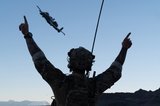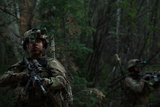Just released: Armoured Vehicles Technology Report 2024 now available to read
In this new Shephard Technology Report, Gerrard Cowan details how the latest technologies are being applied to the oft-neglected but vital area of battlefield engineering, medevac and other non-combat roles in the land domain.
Part 1 surveys leading-edge thinking on using robotic and autonomous platforms for support missions, assessing how close the state of the art is to achieving the goal of equipping frontline units with an uncrewed or optionally crewed vehicle capable of being re-roled to keep soldiers out of harm’s way for all hazardous non-combat tasks.
Talking to Shephard, Ray Moldovan, business development manager at General Dynamics Land Systems, said: ‘UGVs are ideally suited to missions that would be considered dull, dirty or dangerous for a soldier or marine. For example, a resupply mission that involves movement between well-defined points over and over is great for autonomous-enabled UGVs.’
Leveraging a common mobility platform for different missions also reduces the training burden for operators and maintainers and minimises spare parts stockage requirements, said Moldovan.
‘UGVs also are suited for implementation of autonomy systems because they are not intended for human operation. With drive-by-wire architecture, scalable onboard computing, integrated modular sensors and network-ready payloads, UGVs are intended for offset line-of-sight and non-line-of-sight control.’
In Part 2, Gerrard looks to the future of the traditional armoured engineering vehicle (AEV), examining how they can become more versatile and make the best use of developmental technologies, as well as innovative ways of making this specialist capability more widely available across the whole of an army.
Christopher F Foss, internationally recognised authority on AFVs and other weapon systems told Shephard that although combat engineering vehicles and AEVs conduct a wide range of vital roles, the vast majority of nations do not operate a specialised vehicle in the category, with some exceptions, such as the Terrier AEV used by the British Army’s Royal Engineers.
‘That is a very expensive and complicated vehicle, sometimes called a Swiss Army Knife because they do so many things with it,’ Foss said.
Instead, most nations use adapted main battle tanks and other vehicles to fulfil their engineering needs, perhaps fitting them with a dozer blade, a mine clearing device or similar of equipment, Foss explained.
In terms of potential innovation, he said remote-control capability has applications in high-threat areas, such as mine clearance. Further down the track, ‘it will be interesting to see how artificial intelligence (AI) fits into the picture’.
More from Technology Reports
-
![Just Released: Military Training Technology Report December 2024 now available to read]()
Just Released: Military Training Technology Report December 2024 now available to read
In this latest Shephard technology report, Giles Ebbutt highlights the rise of the first person view (FPV) drone as a powerful asymmetric weapon that can …
-
![Just Released: Military Training Technology Report October 2024 now available to read]()
Just Released: Military Training Technology Report October 2024 now available to read
How the latest portable simulation solutions can deliver JTAC training wherever it is needed
-
![Just Released: Space Technology Report]()
Just Released: Space Technology Report
Why space is an essential part of modern military capabilities
-
![Just released: Night Vision & Situational Awareness Technology Report 2024 now available to read]()
Just released: Night Vision & Situational Awareness Technology Report 2024 now available to read
How night vision devices and soldier-worn sensors are underpinning advanced tactical C4ISR capabilities
-
![The imperative for a vibrant UK space industry]()
The imperative for a vibrant UK space industry
Ahead of a new Shephard Technology Report to be published in September, senior executives from Lockheed Martin Space have underlined the importance of investing in defence space systems by countries like the UK.
-
![Just released: Military Training Technology Report 2024 now available to read]()
Just released: Military Training Technology Report 2024 now available to read
How cutting-edge technologies are combining to produce ultra-realistic simulation.
























